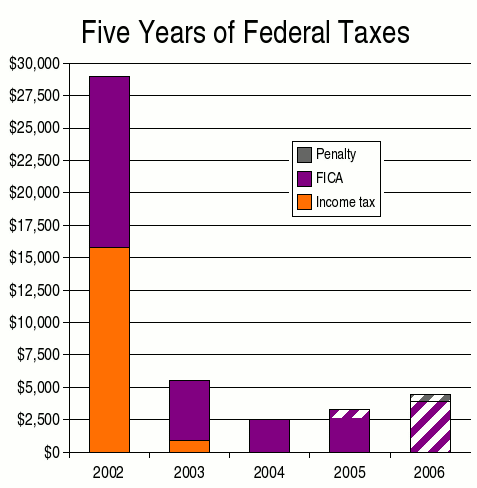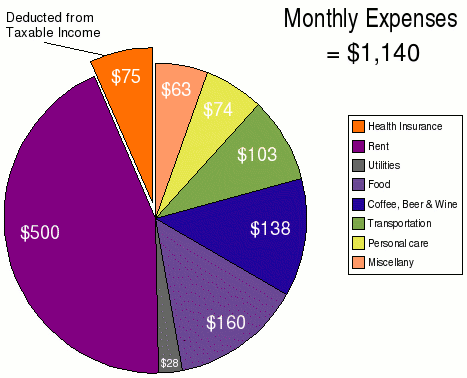This report summarizes . At the end of some sentences, I’ve put links to previous Picket Line entries that expand on some of the topics I mention. You can follow these links by clicking on the ♦ symbols.
Picket Line Annual Report
, the invasion of Iraq began and I quit my job to start an experiment in tax resistance.♦
A review of my goals
My primary goal was to wash my hands of financial support for the U.S. government. I hoped to do this by reducing my federal income tax burden to zero legally — lowering my income below the tax threshold by taking legitimate deductions and credits.
Tax Resistance
In I missed my goal of avoiding all federal income tax, but in I succeeded. (I lump FICA and SECA together under the “FICA” label in this chart):

I stopped paying self-employment tax as well (the white-striped areas in the chart are taxes and penalties I have been assessed but that haven’t yet been collected). Currently, I “owe” about $5,000 (including interest and penalties). I don’t intend to pay this, or any future federal tax, voluntarily. I also don’t have an effective plan to hide my assets, so I expect that the IRS will probably seize the money from me eventually, though so far they’ve only sent me a short series of ominous-sounding boilerplate letters. ♦ ♦ ♦ ♦ ♦
Although excise taxes are a very small part of what the government tries to get me to pay, I’ve adopted avoidance techniques here as well: I’m home-brewing beer to avoid the federal excise tax on alcoholic beverages and I long ago gave up owning a car, so I pay very little federal excise tax on gasoline. ♦
Sustainability
I want to resist taxes over the long term, and so it is important that my expenses remain low enough that my tax-free income is also a sustainable one. I’m happy to report that I’m living sustainably and well at my below-the-tax-line income. ♦
My regular expenses for things like rent, food, health insurance, transportation, utilities and such come to about $1,140 per month — a little less than . My utility bill is way down over , since I’ve moved into my new home, though this is somewhat deceptive — I included the cable bill as part of “utilities” last year and now I don’t have cable but do have Netflix, which I categorize as “entertainment”; also, I do laundry at a laundromat now, which I categorize as “personal care” whereas before we had a washer & dryer at home and that expense too got included in the “utilities” section. My food bill is down also this year, but I appear to be spending most of the savings… c’est le vin as they say.
I’m not sure how I feel about that expanding slice of the pie that goes toward Beverages of Vice. It’s a little embarrassing, given the no-nonsense frugality elsewhere in the budget. On the other hand, it’s nice to know that I have that much room to squeeze my budget further if need be. I could save more than $1,500 per year simply by saying, “I think I’ll just have water, thanks.”
Because I’m self-employed, my health insurance premium is a deductible expense and doesn’t count toward the $15,000 tax-free disposable income that I’m allowed to use under my DON Method of tax resistance (additionally, I qualify for and use a Health Savings Account so my deductible is also tax-free).

Not included in the above graph are any work expenses that I can deduct, and my self-employment tax assessment (half of which I can deduct). My yearly living expenses, therefore, take about $12,780 out of that $15,000. If I budget in the imposed self-employment tax, which I don’t intend to voluntarily pay, but which I expect to lose, this comes to another $4,000, half of which also counts against the $15K. That leaves me pretty much no wiggle room, but I’ve got a little savings I can work with if something unexpected comes up or if I want to splurge (say, on another south-of-the-border vacation).
My 1040: A walk-through
Here’s how I trimmed my 1040 . First, my Total Income:
| Total Income | $27,975 |
|---|---|
| Business income | $27,958 |
| Taxable interest | $519 |
| Ordinary dividends | $108 |
| Capital gain/loss | −$610 |
My business income came mostly from two sources: my contract work and modest profits from sales of The Annotated Hasheesh Eater. The capital loss is mostly attributable to sales of stock in the company I worked for back in the dot-com bubble days.
Now on to my Adjusted Gross Income:
| Adjusted Gross Income | $13,456 |
|---|---|
| Total Income | $27.975 |
| HSA deduction | −$2,650 |
| ½ self-employment tax | −$1,975 |
| Self-employed health insurance deduction | −$894 |
| IRA deduction | −$4,000 |
| SEP deduction | −$5,000 |
Here, I’m able to take advantage of the $4,000 I put into my traditional IRA, the $5,000 I put into my SEP plan, and the $2,650 I put into my Health Savings Account, and I can deduct the complete cost of my health insurance premium as well as half of the imposed SECA tax.
That SECA deduction is because I’m self-employed. When you work for someone else, your employer pays half of your FICA and the other half comes out of your paycheck. This is just silly accounting for the most part, but it does mean that half of your FICA doesn’t count as your income and so you don’t pay income tax on it. If you’re self-employed, you pay both halves and it’s all considered income, so the IRS lets you take half of your SECA tax as a deduction here to even things out.
I came out about $1,500 under my $15,000 AGI ceiling. Even with all of my spreadsheets and planning, I find that it’s difficult to hit the numbers with any precision, and so, as in past years, I erred on the side of caution.
Now we go from Adjusted Gross Income to Taxable Income:
| Taxable Income | $5,006 |
|---|---|
| Adjusted Gross Income | $13,456 |
| Standard deduction | −$5,150 |
| Personal exemption | −$3,300 |
The tax on $5,006 is $501. But by using Form 8880, I got a credit for exactly that much, which reduced my federal income tax to zero, QED.
Other Goals
I hope to encourage other people to consider tax resistance as a tactic and I hope that The Picket Line is a good resource for people doing tax resistance and for those considering it. I keep trying to make it more useful.
The Picket Line has gotten many good reviews and mentions here and there in blog-land.
I have also spread the word elsewhere. For instance, I’ve helped put on workshops held by Northern California War Tax Resistance, I’ve sent many an email to people I thought I might be able to nudge into resistance, I’ve injected the tax resistance meme into discussions online and off, and I’ve started agitating more vocally for tax resistance at peacenik demonstrations. ♦ ♦
One of my projects last year was to write up a new edition of the NWTRCC Practical War Tax Resistance series pamphlet on low-income / simple-living. With the help of some volunteers who helped me with writing and editing the initial draft, I was able to get a review copy ready for the NWTRCC National Conference in Las Vegas last year. Susan Quinlan of NWTRCC finished the final layout earlier this year and it’s now available for download or purchase at NWTRCC’s website. ♦ ♦ ♦
Another of my projects has been to create an on-line collection of Henry David Thoreau’s writing on political philosophy. I had been disappointed with the lack of availability of many of these works, and with the lack of quality in many of those that were available. Over I’ve made great strides toward making available on-line what I hope are good quality versions of many of these works, some of which were not available in any form on-line, and one of which (the collection of journal excerpts) was never available before at all. ♦ ♦ ♦ ♦ ♦ ♦ ♦ ♦ ♦ ♦ ♦ ♦ ♦ ♦
I signed up for the VITA program again , and am helping several low-income families take back thousands of dollars from the U.S. Treasury. ♦ ♦
Some of my other goals might be better classified as “hopes” since I don’t really have a concrete plan of action. I would like to see the following:
- That the U.S. anti-war opposition, and those people who like to think of themselves as part of it, either give up on the Democratic Party entirely or at the very least make their support conditional on reciprocal support for an anti-militarist and anti-war agenda. And, similarly, that libertarian-minded Americans give up the idea that Republican politicians have any interest in a smaller government. Politicians are the problem, not the solution. ♦ ♦
- That the war tax resistance culture learns that the technique of resisting income tax by lowering your income doesn’t mean a life of poverty and deprivation.
- That anti-war left and anti-war libertarian groups learn from each other and join forces against their common enemy. (And that the anti-war left adopt some sensible skepticism about government-based solutions to the problems it identifies.) ♦
- That the anti-war opposition buckle down, take itself more seriously, tolerate less feel-good bullshit, and take a more active stance, insisting on more direct action (war tax resistance would be a great start) and less pleading and protesting. ♦ ♦ ♦ ♦ ♦
- That the war tax resistance movement renounce the counterproductive strategy of advocating a “Peace Tax” legislative non-solution to our collective ethical challenge. ♦ ♦
In support of the goals in that list I have mostly just grumbled and kvetched. I have no position of power or influence in any of the groups I’ve mentioned, and so I am just one opinion among many and my opinion is only as powerful as it is persuasive and available, to which end I have made some effort.
The state of the world and the tax resistance movements
The war drags on, and the U.S. torture policy too, undeterred by law or decency or a Democratic Congress, and only ineffectively and rhetorically opposed for the most part.
The war tax resistance movement remains pretty much where it was last year at this time — a fringe concern, even within the anti-war movement. It continues to be unable to engage people on a large scale.
Prospects for the coming year
Assuming no major unexpected expenses, and assuming the tax law stays roughly the same this year, I’m well-positioned to have of living comfortably and well under the income tax line, though I will “owe” SECA again . I’ve budgeted for the possibility that the IRS will decide to seize money from me for unpaid back taxes, so in case this happens, it won’t slow me down.
